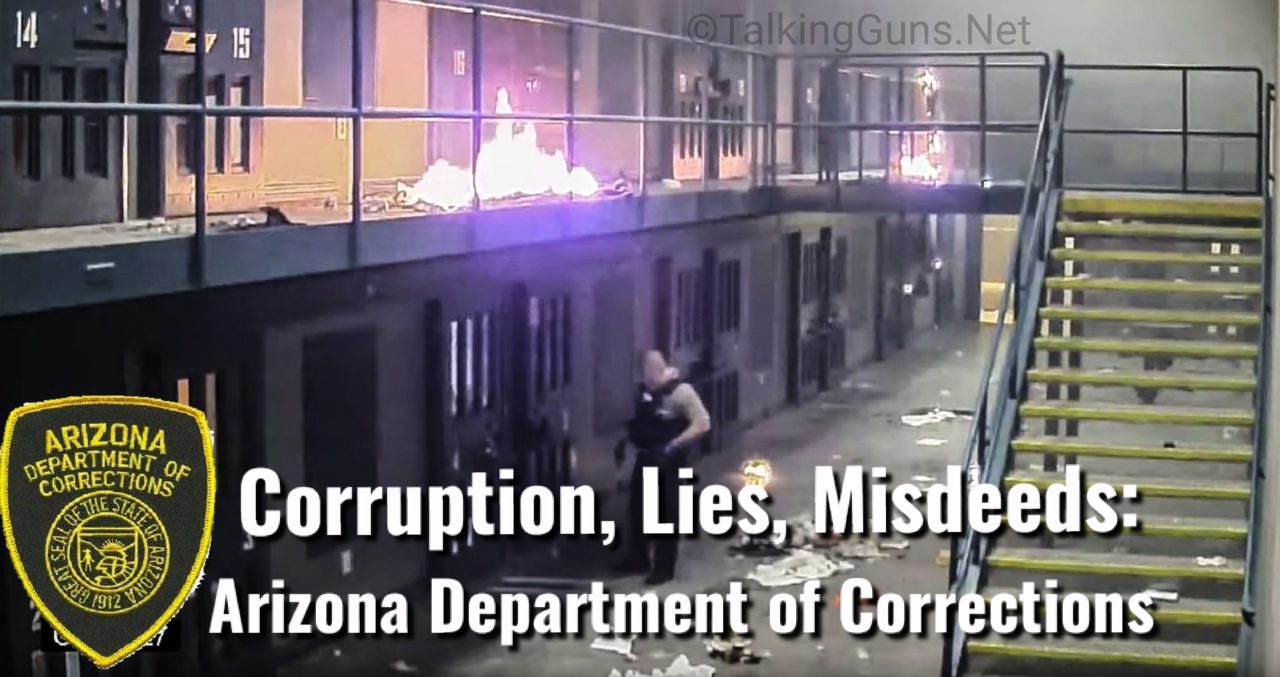
Has Arizona Governor Doug Ducey finally begun to drain his own swamp? Embattled Director Charles Ryan resigned from the Arizona Department of Corrections on September 13, 2019. He stepped down approximately five months after media stories broke regarding broken cell doors and locks at Lewis prison complex near Phoenix, Arizona. He was allowed to retire rather than being fired by Arizona Governor Ducey. Now let’s be honest about this. As much as the Governor would like everyone to believe Ryan had his full support, the controversy surrounding Charles Ryan’s AZDOC administration was a political liability that probably created tremendous embarrassment for the Governor and Arizona state government.
Charles Ryan was like an anchor around Governor Ducey’s neck, pulling him into the abyss, therefore, a decision was most likely made to mitigate the problem. He was replaced by Director David Shinn, a former Federal Bureau of Prisons official, after a nationwide search was conducted for a replacement. AZDOC is at a crossroads. Arizona Governor Ducey, the Arizona State Legislature, and the current director, David Shinn must take decisive action to eliminate the corruption, mismanagement, and cronyism within that agency.
Crucial decisions must be made to either invest in the institution, and transform it into a viable, professional organization, or continue down the current path to its eventual failure and destruction. The department’s current strategy does not seem promising. It appears the agency wants to transform into a department staffed with a cheap labor force (e.g. decreasing the hiring standards, and lowering the minimum age requirement to 18 years of age), hell-bent on a never-ending battle of attrition, while defending its position that it is a stepping stone to other careers. That game plan will not bode well for its future or the safety of its staff, inmates, and the citizens of Arizona.
Two Arizona Department of Corrections whistle-blowers (Sergeant Gabriela Contreras and Associate Deputy Warden Shaun Holland) came forward after filing separate whistle-blower disclosures with the Arizona governor’s office. Sergeant Contreras filed a whistle-blower complaint in May 2019. She alleged corrections officers were repeatedly being attacked by inmates at the Lewis prison complex near Phoenix, AZ because of faulty cell door locks that allowed inmates to leave their cells. Ms. Contreras also leaked AZDOC video surveillance footage of some of the assaults to back up her allegations. AZDOC retaliated against her with economic sanctions and threats of criminal prosecution. The department later rescinded her discipline and ceased their threats with no apology.
Associate Deputy Warden Shaun Holland filed a whistle-blower complaint with the governor’s office in early December 2019, alleging that faulty cell doors at the Lewis state prison complex were not getting repaired despite repeated requests. He stated in the whistle-blower disclosure, “Instead of identifying and repairing the doors, the prison administration is hiding the problems by ‘closing out’ hundreds of repair orders without completing any repairs.” ADW Holland also provided video footage to the media to corroborate his allegations.
During a press conference that ADW Holland attended, he said that AZDOC investigators had questioned him regarding his whistle-blower complaint. They assured him he was not in trouble but he clearly felt that he was the focus of their investigation. Mr. Holland said they previously had all of his information, and he questioned why they were not interviewing others [that had pertinent information] instead of him. He felt they were attempting to disprove his allegations, rather than conducting an unbiased investigation.
Five top department executives have resigned, including former Director Charles Ryan since the local news media reporting revelations. Two retired Arizona Supreme Court chief justices, Rebecca Berch and Ruth McGregor were tasked by Arizona Governor Doug Ducey in April, 2019 to investigate the AZDOC regarding the broken cell door locks at Lewis state prison complex, and to determine if the problem was systemic.The former justices concluded their investigation, and released their report within days after Arizona Department of Corrections Director Charles Ryan announced he would retire on September 13, 2019. The report had several recommendations for improvements within the department, including increased budgeting for infrastructure upgrades, improved training, and strengthening staff and management relationships.
What is striking about the report is that the former justices deduced that AZDOC Director Charles Ryan was “surprisingly uninformed” of the severity and extent of the problems that existed with the security doors and locks. Their report indicated that Mr. Ryan was “misled into thinking the locks were fully functional” but they were being defeated by inmate tampering because corrections officers were not checking the cell door frames for obstructions, and securing them. Director Ryan was characterized as surrounding himself with “yes men” that were afraid to disagree with him, and would distort reports to meet his expectations, for fear of being disciplined or fired. The former director said he did not know the severity of the problem until he viewed the ABC15 news reports featuring the leaked corrections surveillance videos of inmates leaving their cells at will.
I am not questioning the retired chief justices’ integrity or credentials, however, I am puzzled that Governor Ducey tasked them with conducting the investigation into the AZDOC because the justices were former members of the judicial branch of Arizona government. Why did the governor choose to task investigators with ties to Arizona government rather than investigators from outside the state with no appearance of political ties or conflicts of interest? The latter option would have presumably lent more credence to investigatory conclusions reached regarding Ryan’s culpability for the well-publicized Arizona state prison security issues. While the justices did not absolve the former director of the prison security deficiencies, they did not definitively conclude he was fully aware of the severity and extent of the security problems.
According to an ABC15 report posted by Investigative Reporter Dave Biscobing on May 1, 2019, many current and retired AZDOC employees found Ryan’s supposed lack of full knowledge of the security deficiencies difficult to believe. There was ample documentation as well as internal investigations, and prison surveillance videos to confirm overwhelming and ongoing evidence that often reached the director’s office in regard to security issues inside Lewis state prison complex. In addition, the former director was known as having an autocratic management style that seemed to contradict a lack of awareness.
In the interest of transparency and holding the Arizona Department of Corrections accountable to the citizens of Arizona, Talking Guns has posted an AZDOC memorandum with this article. It was composed by Joe Profiri on November 30, 2015, who was the AZDOC Southern Region Operations Director at that time. He is currently the Deputy Director of the AZDOC, and formerly the interim director after Charles Ryan’s departure.
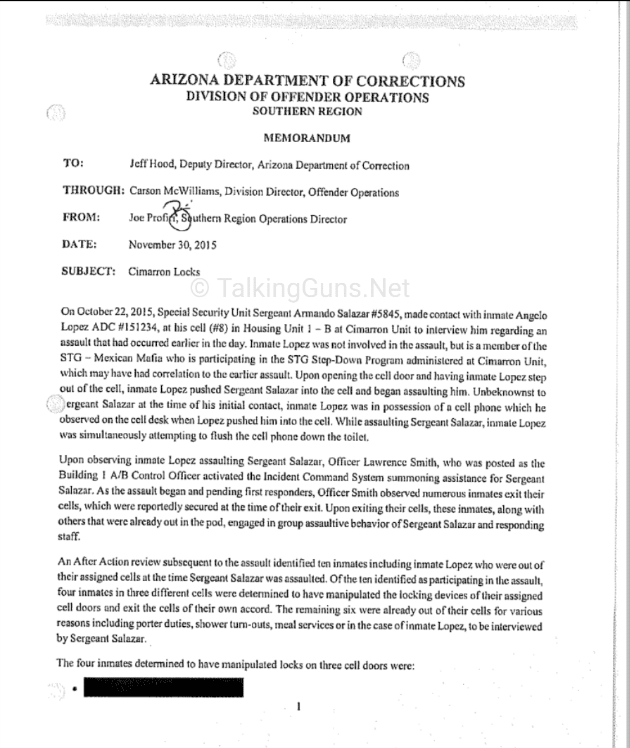
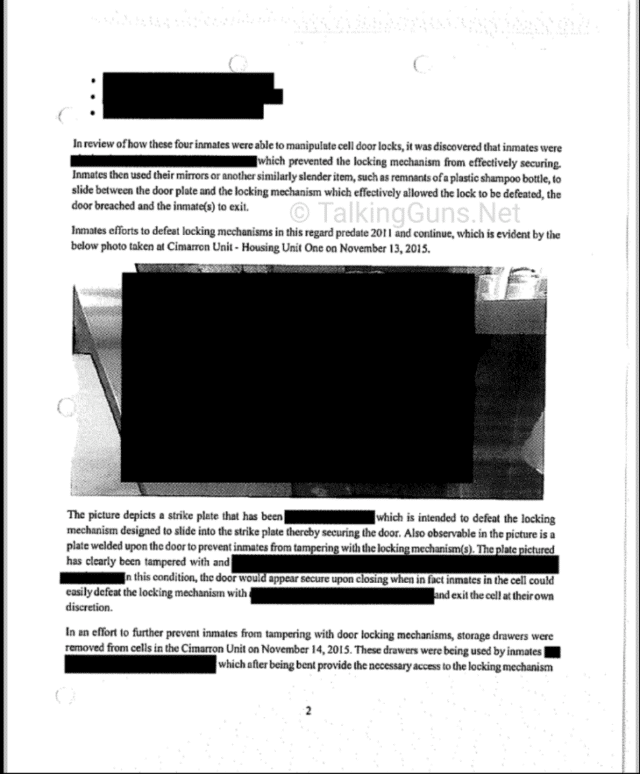
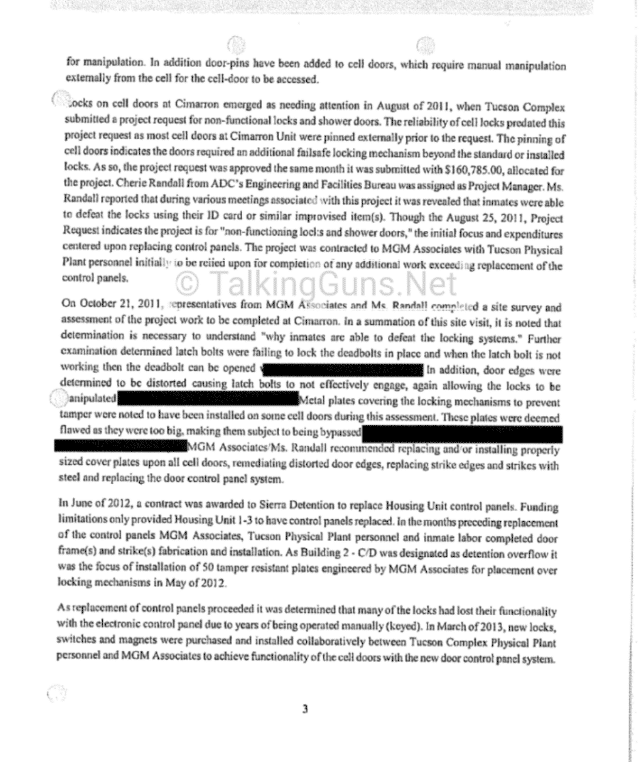
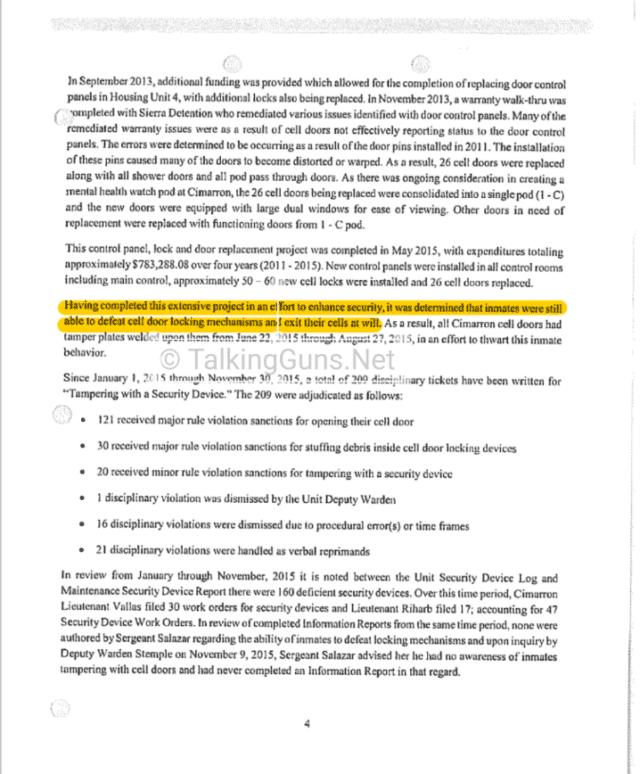
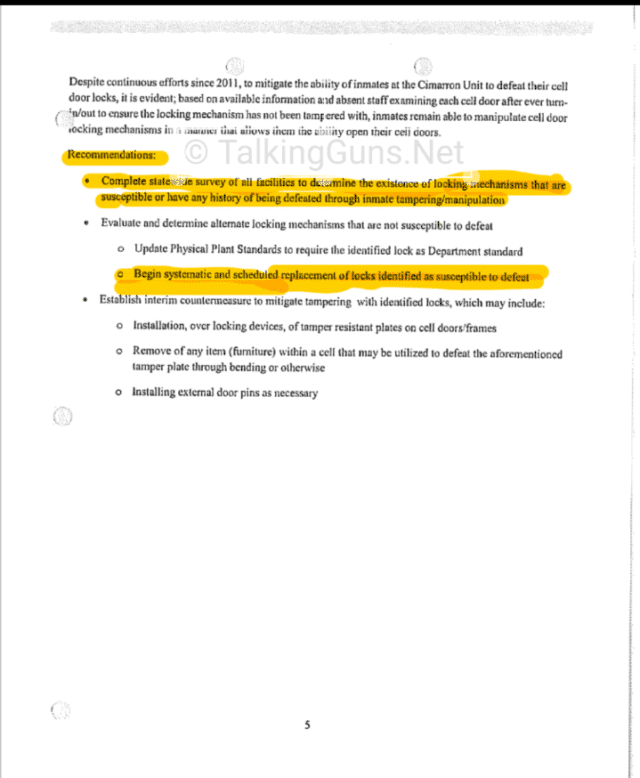
Most of the attention has been focused on the Lewis prison complex near Phoenix, Arizona. The posted memorandum, however, was regarding security issues at the Cimarron state prison in Tucson, Arizona. The document was forwarded to the Arizona Department of Corrections Deputy Director Jeff Hood (who was serving under Director Charles L. Ryan at that time), through AZDOC Division Director Carson McWilliams with Offender Operations. The document described a staff assault by several inmates on October 22, 2015 that led to an after-action review of security doors and locks within that unit.
The review revealed that many cell door security problems existed as a result of design flaws and inmate tampering with security devices. As a result of the cell door security issues, four inmates from three different cells were determined to have manipulated the locking devices on their assigned cell doors that allowed them to exit their cells. Those inmates joined six other inmates that were already out of their cells for various reasons, including, porter duties, showering, and meal services. Those ten inmates engaged in assaults on a staff member identified as Special Security Unit Sergeant Armando Salazar, as well as other staff members that responded to the location to render aid.
Sources told Talking Guns that Sergeant Salazar was unaware of the cell door locking system deficiencies prior to the attack on him. The department already knew about the inmates’ abilities to defeat the cell door locking systems, and placed him in a dangerous, preventable situation. Sergeant Salazar suffered grievous injuries from the assault (including a severe leg injury that necessitated a hip replacement, and a brain injury), and was incapable of returning to work. What was his reward from the Arizona Department of Corrections for putting his life on the line in service to the public and the department? It was the department’s position that it was not responsible for his injuries, and did not believe it could be held accountable for deliberate indifference regarding the safety of its employees. Sergeant Salazar is no longer employed by the department, and is currently social security disabled after receiving a small workers compensation sum. He will most likely be unable to achieve gainful employment because of his injuries.
The memorandum proceeded to detail who was involved in the incident, as well as how the security features on the doors were defeated. Portions of it were redacted, seemingly to preserve institutional security. Interestingly, the memo mentioned a particular method that the four inmates used to defeat their cell door locks and exit their cells. It indicated that those efforts predated 2011 and continued, as evidenced by a photograph of a portion of a security locking device on a cell door, included in the memorandum. The photo was redacted, but according to the memo, it was taken at the Cimarron Unit in housing unit number one on November 13, 2015, and depicted tampering that occurred to the device which would defeat the locking mechanism and allow the cell door to open.
According to the document, the locks on the cell doors at the Cimarron Unit became known as needing attention in August 2011 when the Tucson Complex submitted a project request for inoperative locks and shower doors. The reliability of the cell locks predated that project request, as most of the cell doors at the Cimarron Unit had already been pinned [using steel pins to secure the doors] externally before the request was made. The pinning of the doors indicated the doors required an additional fail safe locking mechanism beyond the standard or installed locks. On October 21, 2011, a site survey and assessment of the project work to be completed, was performed at the Cimarron Unit.
Recommendations were made to improve the existing security devices, and replace door control panel systems. In June 2012 a contract was awarded for control panel replacements for Cimarron housing units. During the control panel replacement process, it was determined that many of the locks had lost their functionality and compatibility with the control panels because of being operated manually with keys for years. In March 2013, new locks, switches, and magnets were purchased, and installed to rectify the functionality and compatibility issues between the cell doors and the new door control panel system. In September 2013, additional funding was provided to complete the door control panel project and replace additional locks.
The entire project was completed in May 2015. It took over four years to complete and cost an estimated $783,288.08. New control panels were installed in all of the control rooms, including main control. Approximately 50-60 new cell door locks were installed, and 26 cell doors were replaced. The memo states, “Having completed this extensive project in an effort to enhance security, it was determined that inmates were still able to defeat cell door locking mechanisms and exit their cells at will. As a result, all Cimarron cell doors had tamper plates welded upon them from June 22, 2015 through August 27, 2015, in an effort to thwart this inmate behavior.”
It further states, “Despite continuous efforts since 2011, to mitigate the ability of inmates at the Cimarron Unit to defeat their cell door locks, it is evident; based on available information and absent staff examining each cell door after ever [sic] turn-in/out to ensure the locking mechanism has not been tampered with, inmates remain able to manipulate cell door locking mechanisms in a manner that allows them the ability [to] open their cell doors.”
The most significant section of the memorandum relates to recommendations that were made as a result of the after-action security review of the Cimarron Unit in Tucson, Arizona. It recommended a complete statewide survey of all facilities to determine the existence of locking mechanisms that were susceptible or had a history of being defeated through inmate tampering and/or manipulation.
It recommended an evaluation to determine alternate locking mechanisms that were not susceptible to defeat, including updating physical plant standards to require the identified lock as department standard, and to begin systematic and scheduled replacement of locks identified as susceptible to defeat.
The review also recommended the establishment of interim countermeasures to mitigate tampering with identified locks, which included: 1. the installation of tamper resistant plates over locking devices on cell doors and/or frames 2. the removal of any item, including furniture within a cell, that could be used to defeat any tamper resistant plate through bending or other methods 3. the installation of external door pins as necessary
Remember, the memo was composed on November 30, 2015 by Joe Profiri, who is currently the second in command of the Arizona Department of Corrections. He indicated that door and lock security issues emerged at the Cimarron Unit in Tucson as far back as 2011. He made recommendations through his chain of command in the 2015 memo for a statewide survey of all facilities to determine the existence of locking mechanisms that were susceptible or had a history of being defeated by inmate tampering and/or manipulation. So why were the cell door lock security issues not identified and fixed at the Lewis prison complex near Phoenix, Arizona? Are we expected to believe that the second in command of the department, who composed the memorandum, did not communicate at any time to his boss, Director Ryan, that this situation existed? Are we also to accept that the memorandum did not make its way up through the chain of command to Mr. Ryan?
The two retired Arizona Supreme Court chief justices, Ruth McGregor and Rebecca Berch, who conducted an investigation of the department’s cell door security issues at Lewis state prison complex, stated in their report, “The Lewis Complex was not included in the requests for funds for prison locking systems in 2014, 2015, 2016, 2017, 2018, 2019, or 2020. (See Attachment 4.) This is so even though, by at least 2017-18, assaults and deaths had resulted in part from the ability of inmates to “access their doors” and leave their cells without having the COs [correctional officers] open the doors for them, and AZDOC leadership had acknowledged being advised that inmates’ ability to get out of their cells had become an increasing problem.”
Let’s summarize this, shall we? The AZDOC brass knew about the cell door security issues as far back as at least 2011, as acknowledged by the aforementioned memorandum by current Deputy Director Joe Profiri. The problems he identified were at the Cimarron Unit in Tucson, Arizona, but he recommended a statewide survey of all facilities to determine the existence of security device problems involving locking mechanisms. The retired chief justices of the Arizona Supreme Court that conducted an internal investigation of the department indicated that the Lewis state prison complex was not included in the request for funds for prison locking systems in 2014 through 2020. I’ll let our readers draw their own conclusions from that information.
There is a call for the removal of those that worked most directly with Charles Ryan during his administration. We at Talking Guns are calling for the dismissals of not only executive staff that were under Ryan’s command, but also Wardens and Deputy Wardens that were complicit regarding the system-wide security failures, and their hazardous effects on public safety, staff, and inmates. It is not enough to simply replace a director and expect real results, and change to occur if you retain holdovers from a previous administration with credibility issues.
Inside sources spoke with Talking Guns and indicated that former Director Ryan knew about the serious security door issues within the Arizona state prison system, including Lewis state prison complex, and the recurring staff and inmate assaults that resulted from cell doors being opened by inmates. Sources said Wardens and Deputy Wardens were aware of the security issues, but when information was relayed to Director Ryan, he allegedly told them he didn’t want to hear about them, and they were instructed to keep the problems at the complex level. It appeared to sources that the former director attempted to insulate himself from a potential crisis situation by creating plausible deniability.
In addition to the potential civil actions that will most likely result from the many security failures of this agency, there is another element that needs to be addressed. Will there be a prosecutorial phase to this correctional saga? Will any AZDOC officials be held criminally culpable for their actions or inaction that led to the death of Inmate Andrew McCormick or others, and the many staff and inmate assaults that occurred as a result of those security door failures? Are the felony charges of criminally negligent homicide and reckless endangerment off the table? How about felony charges of falsification of government documents involving hundreds of falsified cell door repair orders? Homicide has no statute of limitations, and felonies have a statute of limitations of seven years in Arizona.
Is the public just supposed to look the other way and forget what happened? Are the victims, their family members, and friends going to see justice served, or just expected to pick up the pieces of their lives, move on, and forget about their physical and psychological trauma associated with assault or homicide? Do we just let everyone involved in these scandals walk away with their pensions without any criminal accountability?
The Arizona Attorney General and County Attorneys have tremendous prosecutorial discretion in these matters. But what kind of message does it send to the public and crime victims if people involved in these scandals are not held to account? Is the criminal justice system going to send a message that if you are wealthy, or in a powerful position, or politically connected, that you are not above the law, and the rule of law does apply to you? Will there ultimately be justice for any of the victims or is the State of Arizona hoping to just settle the matters in civil court, and that any criminal allegations will get lost and forgotten in the 24/7 news cycle? There are many questions, and I hope the criminal justice system has some answers. At this moment… all I hear…are crickets trilling.
www.talkingguns.net

4 comments
Allen Milner
January 14, 2020 at 11:34 am
Spot on Brian.
talkingguns
January 14, 2020 at 5:01 pm
Thank you sir!
Carl Toersbijns
January 20, 2020 at 6:51 am
Refreshing article and OP-ed on the matter. Employees should be proud of this direct and legitimate approach to the current situation and dilemma. 1. Solutions are many but the first high ranking priority is the safety of all inside prisons in Arizona.
2. Secondly . change the chain of command by replacing grade 21 positions all the way to grade 25.
3. Review the roles of regional directors and administrators in Central Office. There’s too much tolerance for incompetence and poor ethics in those in charge of policies and enforcement in fair open transparency
4. Reallocating funds based on new staffing deployment and work for higher retention of good staff.
5. Review the application of the staff disciplinary policies and grievance requirements for employees to be heard fairly and quickly. No open ended investigations and bring back due processes that are evidence based.
6. Last but not least work on prison reforms to reduce prison population and reallocate resources to keep inmates busy working and reasonably staff to inmates ratio on work details housing areas and yards.
Martin Wayde Nustad
September 12, 2022 at 1:46 am
Ryan got his due. This department is never going to be fixed until legislators are fixed. Review the 2014 summary report of which state is the most corrupt. This report was issued by Harvard University and is the reason why Arizona is the way it is and as long as there is never any “collective” bargaining in this state, this department will never be professional. I.e, such as “California” to compare with. That is the model agency a state should be following. But, in this state, the C/O’s dont even have any levels of arrest powers. We are weak and will forever be weak with bullying directors in charge of it all, for continued corruptive reasons. We need a whole new party.